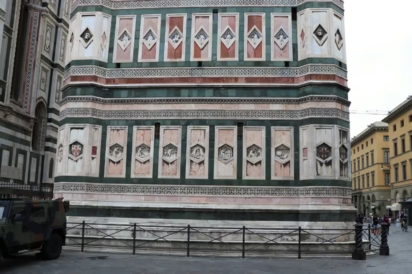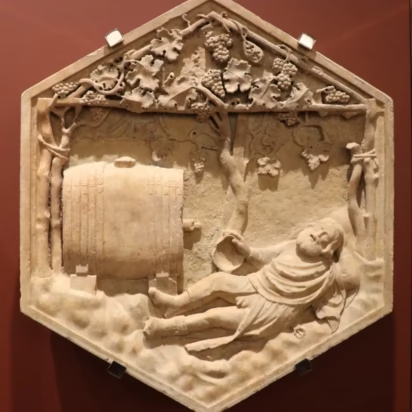The Campanile of Florence Cathedral (Duomo) is a Gothic masterpiece designed by Giotto and is often considered the most beautiful bell tower in Italy.

Giotto added a visual focal point to the skyline of early 14th-century Florence with the magnificent bell tower (campanile) of the cathedral decades before Brunelleschi’s cupola would steal the show. The campanile clad in white, green, and pink marble was richly decorated with relief panels and sculptures. Climb the 414 steps to the viewing platform at 85 m for panoramic views of Florence, the Duomo, and especially the magnificent cupola. Tickets for the campanile are often included for free with guided tours of other parts of the cathedral complex. Time-slot reservations are necessary to climb the bell tower.
Building History of Giotto’s Campanile in Florence
Construction of the cathedral complex in Florence started in 1296 but slowed down and came at times to a complete standstill following the death of its first building master Arnolfo di Cambio in 1302. In 1334, the famous artist Giotto di Bondone, who had considerable architectural experience in addition to his famous paintings, was appointed the new building master for the duomo project.
The 67-year-old Giotto, probably realizing his time was short, concentrated his efforts on the campanile. He was keen to set an architectural highlight for Florence and knew the bell tower would be simpler and faster to complete than the cathedral, which was not only much bigger but also had the problem of the large dome that would be difficult to build, to put it mildly, given not only the technology of the time but also a lack of wood in Tuscany and the ever-present question of financing.
The foundations for the campanile were already laid by Arnolfo di Cambio three decades earlier so Giotto was restricted by the established dimension and location, which in line with the western facade of the cathedral was unusual. The resulting tall but slender sandstone tower with polychromatic marble cladding of the entire external structure is an architectural and artistic masterpiece.
Structurally, the bell tower was relatively easy to build but Giotto went over the top with the art, which slowed the project down a bit. At the time of his death in 1337, only the first level was completed. His friend and confidant, Andrea Pisano, completed the second level to Giotto’s designs. (Pisano previously created a set of bronze doors for the baptistry.)
Completion of the Bell Tower of the Duomo in Florence
The Campanile of Florence Cathedral was finally completed by Francesco Talenti, who led the work from 1350 to 1359. The upper three levels without further statues and reliefs followed the white, green, and pink marble cladding of the lower stories. He added gabled windows with beautifully crafted twisted columns.
The bell tower has 12 bells, of which only seven can currently be rung. The oldest, and heaviest, is the Campanone / Santa Reparata cast in 1705. It has a diameter of 2 m and weighs 5385 kg. Most of the other working bells are from the mid-20th century.
The bell tower is topped by a slightly protruding bastion, which is a popular and fairly easily accessible viewing point. The fairly flat, tiled pyramid-shaped roof is not visible from ground level. The 30-m high spire that Giotto planned was never built.
The free-standing bell tower has a square floor plan with the sides 14.45 m (47.41 ft) wide. It stands 84.7 m (278 ft) tall high — only around 10 m lower than the platform on top of Brunelleschi’s cupola.
Art and Decorations on Giotto’s Campanile in Florence
Giotto placed all the artistic appeal of the campanile on the exterior allowing anyone to enjoy the art at any time for free without ever having to enter the building or climbing any stairs. However, note that the reliefs and sculptures are casts — the originals are now in the museum.
The artworks are mostly on the three sides facing away from the cathedral. Giotto left empty the northern side that almost touches the church. The art here was later additions with some items moved from the east side when the doors to the tower were enlarged.
The artworks decorate the lower three levels of the tower: the lower band of bas reliefs are in hexagonal frames, the second level of rhomboid reliefs are of marble figures on a blue majolica background, while statues are placed in niches on the third level. The higher floors have only the geometric patterns of the colored marble and the fine portal openings for the bells.
Giotto and Pisano Reliefs on the Campanile in Firenze
Giotto probably designed many of the reliefs but it is impossible to clearly attribute the actual works to specific artists. A few were possibly made by Giotto but most are now attributed to Andrea Pisano and his workshop.
Although the reliefs are clear, modern visitors may struggle to correctly attribute the picture to the specific “art” it is symbolizing (“science” came only much later). So with the help of Wikipedia and especially the very comprehensive Italian page:
History of Humanity
The hexagonal panels on the lower level depict the history of mankind:
- Inspired by Genesis, starting with on the west side: Creation of Adam, Creation of Eve, First Labors (post paradise), The beginnings of “mechanical arts” and “creative arts” (according to the Bible): Jabal (animal husbandry), Jubal (music, harp, and organ), Tubalcain (first blacksmith), Noah (farming and wine).
- The seven hexagonal panels on the south side: Gionitus (Astronomy), the Art of Building, Medicine, Hunting, Wool-working, Phoroneus (Legislation), and Daedalus (flight).
- The east side only contains five panels, as two were moved north when the door was enlarged: the ‘liberal arts’: Navigation, Social Justice, Agriculture, Art of festivals, and Euclid (architecture).
- The north side hexagonal panels depict: Sculpture (Phidias), Painting (Apelles), Grammar (Prisciano), Philosophy (represented by Plato and Aristotle), Music and Poetry (represented by Orpheus), Geometry and Arithmetic (represented by Euclid and Pythagoras), and astrology (Phytogoras). The first two panels are attributed to Andrea Pisano. The last five panels by Luca della Robbia were added after the removal of the raised passageway between the campanile and the cathedral.
The second level of rhomboid reliefs are of marble figures on a blue majolica background. These are mostly attributed to Andrea Pisano or his school. The seven themes on each of the four sides are planets (west), theological and cardinal virtues (south), liberal arts (south), and sacraments (north).
Statues on the Bell Tower of Florence Cathedral
The 16 niches on the second floor were filled with sculptures by talented Florentine artists. The sculptures are now mostly inside the museum with fine copies now adorning the tower.
The four statues on the western side are probably by Andrea Pisano and are Gothic in appearance and are similar to high reliefs with unfinished backs. The prophets on the south side are already more classical in appearance but also date from the original building period.
The sculptures on the east and north sides are newer and from the early 15th century. Most are attributed to Donatello with the most noteworthy being his beardless prophet (probably a portrait of Brunelleschi) and the bold Habakkuk.
→ Sculptures by top artists similarly decorate the exterior of the nearby Orsanmichele Church.
Climbing Giotto’s Campanile in Florence
Visiting the campanile is a simple affair. There is hardly anything inside the tower other than the stairs leading to the top.
It is 414 steps to the viewing platform at the top — 50 fewer than to the top of the dome. Also, the staircase is relatively wide with many platforms suitable for those needing a rest making it far easier to scale than the more claustrophobic final assault on the dome.
The bell tower is open every day with long hours — usually around 8:30 to 19:00.
Time-slot reservations are currently required and are made during the process of buying the Giotto Pass. (Visitors with a Brunelleschi Pass to climb the dome, may enter the campanile freely without timeslot reservations any time within three days of climbing the more challenging cupola.)
→ See Tickets and Opening Hours for Visiting the Duomo Sights in Florence for more details. Currently, a Giotto Pass is the minimum requirement for climbing the bell tower (or a Brunelleschi Pass that additionally includes climbing the dome). Both passes also include access to the baptistery and the museum.
→ See 2025: Florence New Opening Hours of Top Sights, Museums, and Churches for the latest information and current opening hours.
More on the Duomo in Florence
- Visit the Cathedral of Florence (Duomo di Firenze)
- Visit the Baptistry (Battistero)
- Climb Giotto’s Campanile
- Climbing the Brunelleschi Campanile
- Museo dell’Opera del Duomo (Museum of the Works of the Cathedral)
- Tickets and Opening Hours for Visiting the Duomo Sights in Florence
- Current Opening Hours for Top Sights in Florence
- Guided Tours of the Duomo Sights
- More Photos on Flickr
More Articles on Florence Sights
The high season in Florence is increasingly long: Easter, May, July, August, and the Christmas holidays are especially busy. November and January to mid-March are the only quiet months, except for the February school holiday week. Plan and book time-slot reservation tickets and tours when available in advance — the Accademia and the Uffizi are again sold out weeks in advance. Top sights are quieter directly at opening time or in the late afternoon.
→→ Opening hours for top sights in 2025 — most sights have long hours but advance time-slot reservations are always sensible.
- Tips on Buying Tickets for the Uffizi Museum
- Tips on Buying Skip-the-Line Tickets for the Accademia (Michelangelo’s David)
- See Michelangelo’s David in the Galleria dell’ Accademia
- Visit the Duomo sights: Cathedral (Duomo), Baptistery (Battistero), Bell Tower (Campanile), Dome (Cupola), Museum (Museo), and Tickets + Opening Hours
- Visit the Bargello Museum of Sculpture (Donatello’s Davids)
- Visit San Marco Museum to see the frescoes and altarpieces painted by Fra Angelico.
- Visit Santa Maria Novella Church and Museum to see medieval and Renaissance Art.
- Visit Santa Croce for Giotto Frescoes and Michelangelo’s Grave
- San Lorenzo complex: Visit the Basilica for Renaissance Art, See the Laurentian Medici Library by Michelangelo, and Visit the Medici Chapels (Michelangelo Statues)
- Visit the Orsanmichele Church and Museum with sculptures.
- Save on Sightseeing in Florence with the Firenze Card (again available but not including transportation or the Duomo sights, or consider the Turbopass Florence City Pass that includes online timeslot reservations for both the Uffizi and Accademia.
- Travel to Pisa to see the Field of Miracles and the Leaning Tower of Pisa.
- Visit the magnificent Romanesque-Gothic cathedral in nearby Siena.
- Save on top Italian designer fashion at The Mall Factory Outlet Stores.
Florence Resources
- The official website of the Firenze Tourist Office is a bit cumbersome but has very useful information. Especially the pdf (alternative link) with the opening hours of all major sights. Unfortunately, it is only available for the current month but it is the second last line on opening hours — the final say is the guard at the door, NOT the ticket window!
- Get Your Guide offers tours of all major sights while Tiqets sells online tickets for many top sights in Florence.
- Book luggage storage online and explore Florence more easily on foot.
- Trainline is good for booking online train tickets in Italy and most of Europe.






